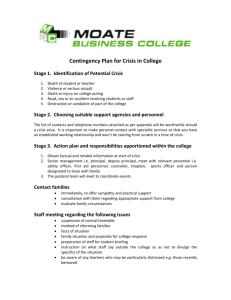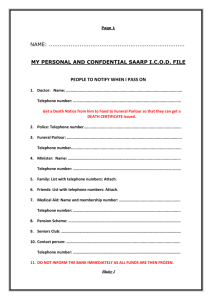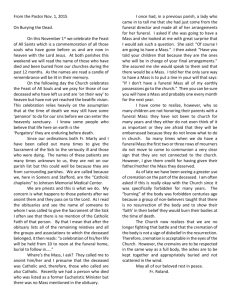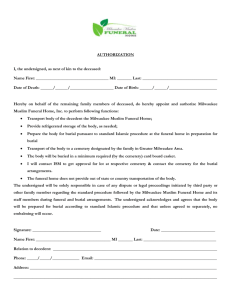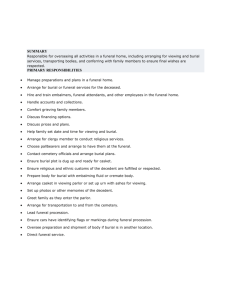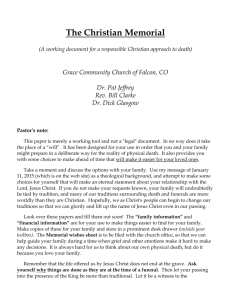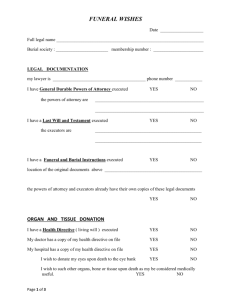Coping with Loss and Grief:
advertisement
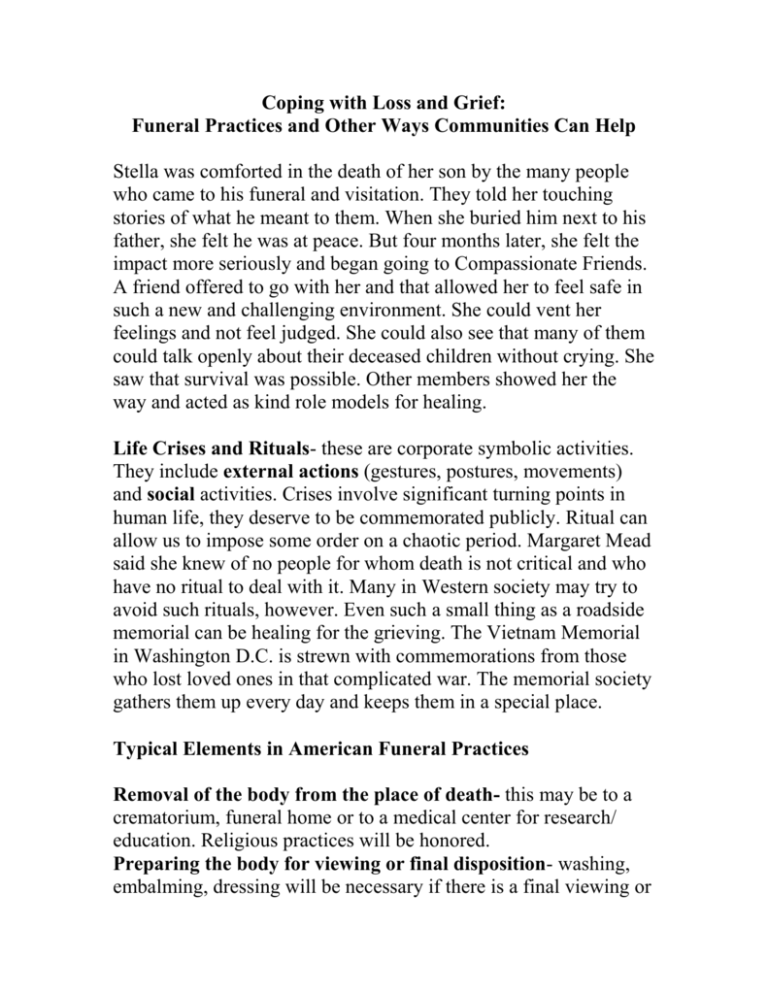
Coping with Loss and Grief: Funeral Practices and Other Ways Communities Can Help Stella was comforted in the death of her son by the many people who came to his funeral and visitation. They told her touching stories of what he meant to them. When she buried him next to his father, she felt he was at peace. But four months later, she felt the impact more seriously and began going to Compassionate Friends. A friend offered to go with her and that allowed her to feel safe in such a new and challenging environment. She could vent her feelings and not feel judged. She could also see that many of them could talk openly about their deceased children without crying. She saw that survival was possible. Other members showed her the way and acted as kind role models for healing. Life Crises and Rituals- these are corporate symbolic activities. They include external actions (gestures, postures, movements) and social activities. Crises involve significant turning points in human life, they deserve to be commemorated publicly. Ritual can allow us to impose some order on a chaotic period. Margaret Mead said she knew of no people for whom death is not critical and who have no ritual to deal with it. Many in Western society may try to avoid such rituals, however. Even such a small thing as a roadside memorial can be healing for the grieving. The Vietnam Memorial in Washington D.C. is strewn with commemorations from those who lost loved ones in that complicated war. The memorial society gathers them up every day and keeps them in a special place. Typical Elements in American Funeral Practices Removal of the body from the place of death- this may be to a crematorium, funeral home or to a medical center for research/ education. Religious practices will be honored. Preparing the body for viewing or final disposition- washing, embalming, dressing will be necessary if there is a final viewing or wake. Embalming became popular after the Civil War as bodies were removed from battlefield cemeteries to ship them home for burial. Lincoln had quite a trip home to Springfield, Illinois from Washington D.C. for his final burial. He had to be embalmed more than once to preserve the body for viewing along the way. Embalming entails draining the blood and fluids from the corpse and replacing them with preservatives that retard decomposition. It is required if the body will be carried to a site on a plane or train. It is primarily done to allow viewing of the body at an open casket wake. This also allows time for family to get to the site of the burial and for a final viewing of the deceased. A viewing of the body- this may entail a fully or half open casket, as mourners come forth and speak to the dead person, say a prayer for them, touch or kiss the body. This viewing does impress on the survivor the reality of the death. Visitors often tell stories of the deceased as they secure the person in their memory. A funeral service- usually a clergy person says a prayer or even sermon over the deceased. Others may say a eulogy, a remembrance of the deceased, as they all support one another. Delivery of the body for final disposition- permits must be received if the person will be buried or moved to another place for burial. In-ground burial or aboveground entombment in a crypt- inground burial is the most common form of body disposal in the US. Different religions have different practices about how soon after death a body should be buried. There may be a procession of cars following the hearse from the chapel to the cemetery, then a grave-side service, and possibly symbolic tossing of dirt over the casket. Usually mourners leave before the body is lowered into the grave. Cremation occurs when the body is placed in some flammable container (it doesn’t have to be a casket) and heated to 1,600 to 1,800 degrees F for 2+ hours. Ash and bone fragments are ground up- cremains for burial or scattering in the sea. Some people keep the urn in a special place or in a mausoleum. Cremation has become more popular in the last few years- it is expected to be over 38% of deaths by 2010. Above ground entombment is becoming more popular, but is almost a necessity in places like New Orleans with a very high water table. Some newer cemeteries that are eco-friendly require the body to not be embalmed, but buried in a container that will decompose naturally. Donation of the body for medical research or teaching has become more common, but it requires immediate preservation in a particular way, so the body will not be available for viewing. Sometimes only parts of the body are donated (corneas, etc.) so once those are removed, the rest of the body can be cremated or buried. Memorial service is much like a funeral, but without the body present. It is a way of controlling costs and for some, it shifts the focus on to the person, not the body. Funeral costs can be controlled by buying a pre-need plan in which specific plans for the service can be made, even by the person himself. Disaster Mortuary Operational Response Team is one of the roles that funeral directors assist with when there is a disaster. They establish a temporary morgue, assist in victim identification, and process the remains for disposition. There are other viewpoints regarding American funeral practices: 1) Abolish post-death rituals- they are a waste of money, time and represent a flight from reality 2) Modify these rituals- more emphasis on memorial services rather than viewings and funerals 3) Continue traditional rituals with minor alterations- these rituals help people make sense of and establish order in a disruptive time Funeral directors receive high marks from the public for how they aid the families in these trying times. They offer comfort and control in a time when people feel out of control. Three Tasks Associated with Funeral Rituals 1) Disposition of the body- people are very uncomfortable with the idea that a corpse is just discarded (horrifying images of Katrina) so disposition needs to be in sync with customs of the group 2) Making real the implications of death- seeing the deceased makes real the death and helps achieve separation from the deceased. So after a trauma, it is important to identify the remains or any part of the person. The funeral also helps in separating from the deceased. Critics say the expensive coffin linings, pillow under the head of the deceased, all promote an idea of life, not death. Others say this final image can be reassuring to the bereaved. The costs of an elaborate funeral may be seen as a last sign of love for the deceased- it is said to be the third most significant expenditure in a person’s life, after a house and car. 3) Reintegration and ongoing living- there is disintegration when a loved one dies. The challenge for the bereaved is to achieve a new integration and assume meaningful living. Disintegration occurs on four levels: a. A loss of integrity or wholeness within themselves (loss of regular habits, even identity) b. Disintegration at the family level (economic impacts, disruptions in relationships) c. Disintegration at the social level (especially for a well-known person, a leader) d. Disintegration at the spiritual level (sense of being alienated from one’s higher power, anxiety, fear) Funerals can aid reintegration since family members visit and friends pick up the slack in everyday functioning for a bit. In some cultures there are traditions of commemorations over the following year to aid the bereaved in moving into a new world without the deceased. Funeral directors and hospice programs have aftercare programs with grief support groups and newsletters to help grieving people move forward. With public figures, there are often public memorials where people can draw together to support one another. (When Princess Di died, there was such a public outpouring of grief that the queen was forced to come forth in a public recognition of the loss.) Cemeteries and other memorial activities- these have been places of remembrance for hundreds of years, so they have developed to be pastoral and peaceful for the visitors. There are even sculptures that offer comfort to the survivors. Newer headstones even incorporate videos of the deceased which visitors can play. Memorial photography used to be popular but is less so today, although some videotaping is requested at the memorial. There are photographs of celebrities online as well. Some people are uncomfortable with photographing the dead, however. GriefNet.org is a place which people can write grief reactions and connect with other grieving people. Aftercare- any assistance or support offered to the bereaved after the funeral and friends have left and gone home. Funeral directors offer some of this- listening, helping the bereaved deal with paperwork, providing literature on grief. Some funeral homes offer support groups, a library, holiday programs, children’s programs or in-service training for counselors. Bereavement in Hospice Programs- because hospice is seen as a holistic endeavor, there is much support to the family members after a hospice death. There may be cards, newsletters, and grief groups. Their services are open to the public, whether the person who needs it used their services or not. Support Groups for the Bereaved- this may include talks and lectures on practical issues following death, and some groups actually have people who can help the survivor with repairs, tax preparation, ideas for investment or managing finances. One group is called LIFT- for Living Information for Today. Other support groups include entertainment and social activities. Those groups who offer coping aid are usually self-help. Members have been through loss and by their own stories and modeling, offer strength and hope to new members. Principles of Bereavement Support Groups Most people don’t need professional counseling, but they need to see there is hope and a better day to expect. Volunteers who are trained usually facilitate these groups and they may be open or time-limited in nature. Most of the bereaved were functioning normally before the loss, so it is hoped that once they reintegrate their loss, they will function well again. There is an expectation of confidentiality, nonjudgmental attitude, no advice, opportunities for all to speak, no side conversations, you can pass or remain silent, and what is shared is to be respected. Why are support groups so helpful? Eight Helping Factors of groups 1) Identification 2) Universality 3) Catharsis 4) Guidance 5) Instillation of hope 6) Existential issues 7) Cohesiveness 8) Altruism and empowerment
